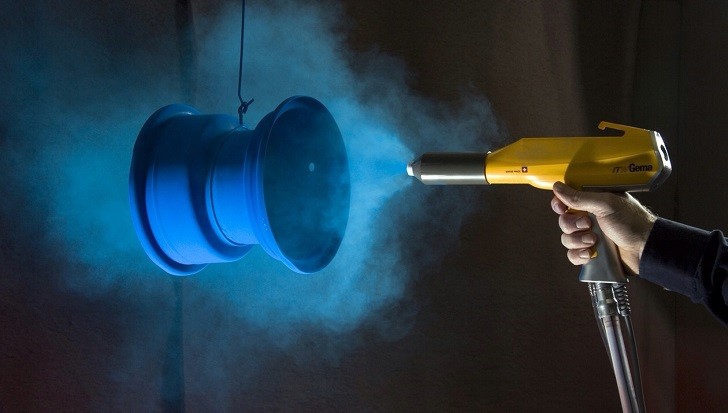Being gifted with seeing all the colors of the light spectrum, humans started coloring things since ancient times, using different combinations of plant and rock dies. Now, we have dozens of solutions depending on what it needs to be painted, from the classic acrylic brush paint to sophisticated electrostatic powder coatings.
And because your car project is like you child and you want all the best for it, we'll cover the advanced powder coating section here, which comes with a lot of advantages.
Another advantage is that several powder colors can be applied before baking (curing) the part, which will blend in a single neat layer. The layers' neatness comes as the electrically-charged particles will always try to find an uncovered surface area on the part, thus creating an even coat.
The perfect particle arrangement is continued on the next layers ensuring a resistant coating which will last longer than classic solvent-based paints.
The thermoplastics just flow into the final coating during the baking process.
1. Preparation: using a variety of chemicals and mechanical methods, the part needing to be painted has to be cleaned of any contaminants such as oils, soil, metal oxides, welding scales, lubrication greases and other impurities. This part can also include chemical pre-treatments involving phosphates or chromates to assure a better surface bonding between the part and the color coat.
2. Spraying the powder: the most common way is by using an electrostatic gun. The gun puts a positive charge on the powder particles and then sprays them to the grounded object needing to be painted.
3. Curing: after the desired layers of powder have been applied to the part, they need to merge and stick to the surface, just like in Photoshop. This is done by subjecting the coated part to temperature of around 200 degrees C (390F) for 10 minutes.
What is it?
As the name suggests, the procedure consists of applying an even coat of paint to a metallic piece in the form of electrically-charged 30 to 50 micrometer paint particles which stick to the part that is grounded.Nice! But what's different from the classic spray painting?
Powder paint doesn't need carrier smelly fluids which evaporates as the coat dries. So the process is less toxic and you can also apply a thicker coat because there will be no paint running or sagging.Another advantage is that several powder colors can be applied before baking (curing) the part, which will blend in a single neat layer. The layers' neatness comes as the electrically-charged particles will always try to find an uncovered surface area on the part, thus creating an even coat.
The perfect particle arrangement is continued on the next layers ensuring a resistant coating which will last longer than classic solvent-based paints.
Are there different powder coating types?
Yes, there are two main categories: thermosets and thermoplastics. The thermosets feature a cross-linker into their formula and when the powder is baked it reacts with other chemicals to polymerize.The thermoplastics just flow into the final coating during the baking process.
How the powder coating process is done?
As with other types of painting, powder coating is done in three steps:1. Preparation: using a variety of chemicals and mechanical methods, the part needing to be painted has to be cleaned of any contaminants such as oils, soil, metal oxides, welding scales, lubrication greases and other impurities. This part can also include chemical pre-treatments involving phosphates or chromates to assure a better surface bonding between the part and the color coat.
2. Spraying the powder: the most common way is by using an electrostatic gun. The gun puts a positive charge on the powder particles and then sprays them to the grounded object needing to be painted.
3. Curing: after the desired layers of powder have been applied to the part, they need to merge and stick to the surface, just like in Photoshop. This is done by subjecting the coated part to temperature of around 200 degrees C (390F) for 10 minutes.

